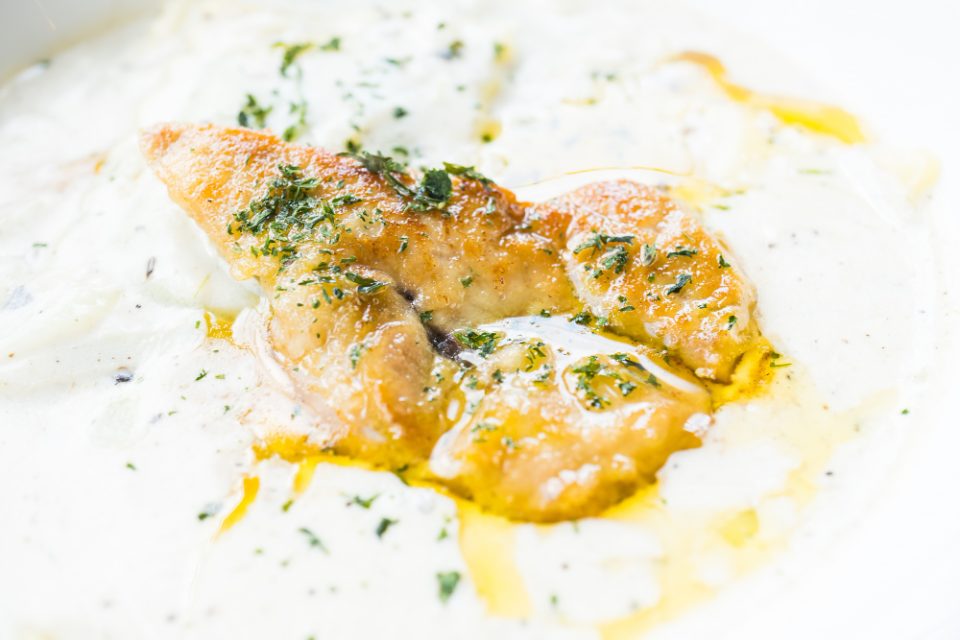“Super salty British-style battered fried fish” is the simplest way to describe filetti di baccalà. For days, salt cod fillets are submerged in water to rehydrate, soften, and reduce the saltiness of the flesh. The fish pieces are dipped in a thin batter comprised of flour and sparkling water (there is no beer in this recipe, but occasionally an egg is included) and fried until crunchy and golden. The baccalà is well-seasoned after the pre-fry soaking period, and it has a flaky yet notably hard texture that can withstand the crunch of the batter. The fish only needs to be seasoned with a squeeze of fresh lemon juice.
Although it may seem a stretch to compare Roman fried baccalà to British fish and chips, both meals were probably brought to Rome by Sephardic Jews who emigrated from the Iberian peninsula. The dried cod, also known as stoccafisso or stockfish in Italian, was introduced to Southern Italy during the Norman conquest at the beginning of the second millennium CE. But it wasn’t until the end of the 15th century, when Sephardic Jews were driven out of Spain and Portugal, the world’s two biggest producers of salt cod, that salted dried cod started to appear on the Italian peninsula.
At sit-down pizzerias in Rome today, filetti di baccalà are typically served as an appetizer. These establishments have deep fryers to handle the fish frying, and the pizzas they produce from their wood-burning ovens help to cover up the smell of the frying fish. Due to their extremely short shelf lives, battered fritti like squash blossoms or salt cod are typically not made in pizza al taglio establishments.
Although it is very easy to make filetti di baccalà at home, in the US the requisite soaking necessitates some planning. (Salt cod dealers in Rome frequently have tubs of baccalà that are already soaked so that consumers can use it right away when they get back home). You need true salt cod fillets, not the belly and tail pieces that many establishments try to put in adorable little wooden boxes. While such components work well to create brandade, they are ineffective in this situation. Soak the salt cod for three days, which is the optimal amount of time to do so in order to reduce the saltiness of the fish without turning it to mush. Change the water frequently, ideally twice daily. All that is left to do now is to slice it into long strips, coat the strips in batter, and fry them.

Ingredients
For the Salt Cod:
- 910g skinless salt cod fillets, in large pieces
For Frying:
- 4 quarts (4L) vegetable oil
- 2 cups (260g) all-purpose flour
- 1 cup ( 140g) cornstarch
- 2 teaspoons baking powder
- 1 ½ cups plus 4 tablespoons (420ml) chilled sparkling water
- ½ cup (120ml) vodka
- Salt
- Lemon wedges, for serving
Directions
- For the salt cod, three days before frying: Salt cod should be thoroughly rinsed under cold running water to remove any salt residue.Place in a big container and then cover with more water. Change the water multiple times, ideally twice daily, over the course of the 72-hour refrigeration period. (Longer soaking will lessen the fish’s salinity; nonetheless, salt cod will always be somewhat salty.)
- Drain the salt cod, then rinse it with ice water and wipe it dry with paper towels. Partition the fillets with a sharp knife into pieces that are 6 inches long and 1 1/2 to 2 inches broad (it’s okay if the portions are a little bit smaller or larger).
- When Ready to Cook, for Frying: Oven temperature should be set at 200°F (95°C) with the rack in the middle position. Insert a wire rack and paper towels into a baking sheet with a rim. Oil should be heated to 375°F (190°C) in a sizable Dutch oven over medium-high heat.
- In the meantime, combine the flour, cornstarch, and baking powder in a large bowl. Using chopsticks, mix in the vodka and sparkling water until a batter just comes together. Avoid over-mixing; a few flour lumps are acceptable.
- To the batter, add half of the salt cod. Keep them apart if you have a mixture of thick and thin tail pieces, and batter the thick fillets first. To equally coat the pieces in batter, submerge them. Lift each piece of cod from the batter one at a time, letting any excess batter drip back into the bowl, and carefully place it in the hot oil, lowering it gently to prevent splashing. Repeat with the remaining pieces of battered cod. Fry cod, flipping occasionally, for 5 to 6 minutes for thin tail pieces and 7 to 8 minutes for thick fillets, or until batter is golden brown and crisp on all sides. Transfer the cod to the wire rack that has been prepared, sprinkle with very little salt, and then place in the oven to maintain warmth.
- Remove from the oil the browned batter pieces and throw them away. Repeat steps 5 and 6 with the remaining cod, raising the oil’s temperature to 375°F (190°C). Serve immediately with lemon wedges after transferring to a serving plate coated with parchment or butcher paper.

